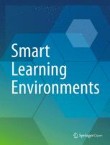Smart Learning Environments is affiliated with the International Association of Smart Learning Environments. This journal is supported by National Engineering Laboratory for Cyberlearning and Intelligent Technology and Smart Learning Institute of Beijing Normal University.
Psychology course redesign: an interactive approach to learning in a micro-flipped classroom
A micro-flipped classroom combines the traditional lecture-based course and the flipped classroom for a blended mixture of the two pedagogical approaches. It allows the instructor time to lecture in class, whi...
